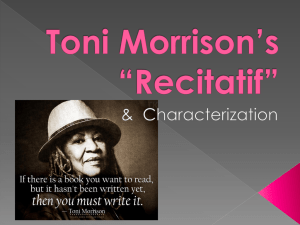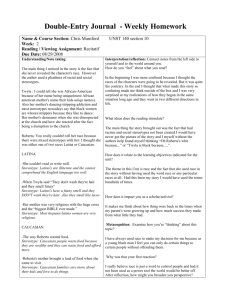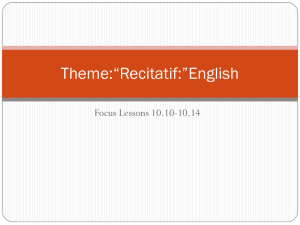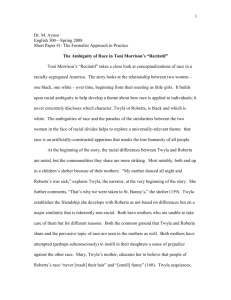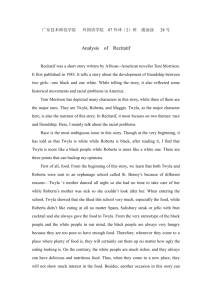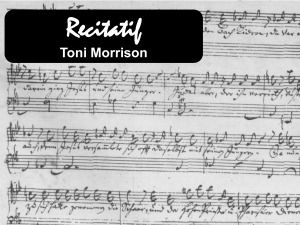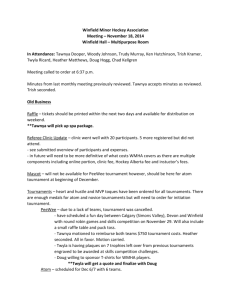"Recitatif" by Toni Morrison
advertisement
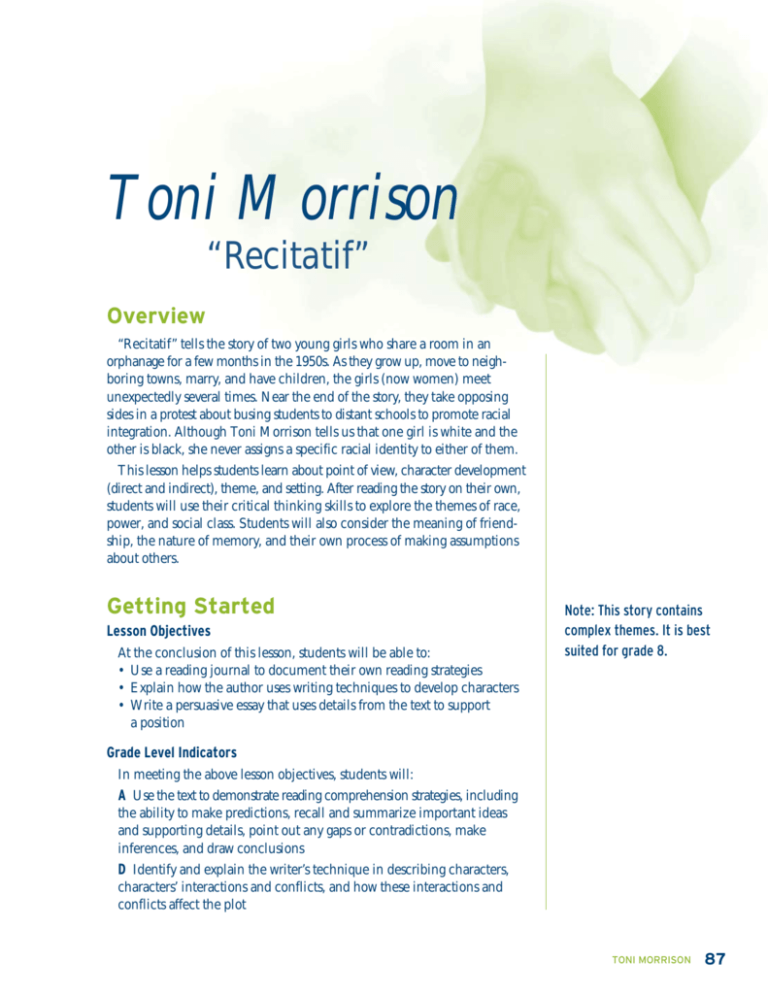
Toni Morrison “Recitatif” Overview “Recitatif” tells the story of two young girls who share a room in an orphanage for a few months in the 1950s. As they grow up, move to neighboring towns, marry, and have children, the girls (now women) meet unexpectedly several times. Near the end of the story, they take opposing sides in a protest about busing students to distant schools to promote racial integration. Although Toni Morrison tells us that one girl is white and the other is black, she never assigns a specific racial identity to either of them. This lesson helps students learn about point of view, character development (direct and indirect), theme, and setting. After reading the story on their own, students will use their critical thinking skills to explore the themes of race, power, and social class. Students will also consider the meaning of friendship, the nature of memory, and their own process of making assumptions about others. Getting Started Lesson Objectives At the conclusion of this lesson, students will be able to: • Use a reading journal to document their own reading strategies • Explain how the author uses writing techniques to develop characters • Write a persuasive essay that uses details from the text to support a position Note: This story contains complex themes. It is best suited for grade 8. Grade Level Indicators In meeting the above lesson objectives, students will: A Use the text to demonstrate reading comprehension strategies, including the ability to make predictions, recall and summarize important ideas and supporting details, point out any gaps or contradictions, make inferences, and draw conclusions D Identify and explain the writer’s technique in describing characters, characters’ interactions and conflicts, and how these interactions and conflicts affect the plot TONI MORRISON 87 E Identify and analyze the importance of setting (time, place, and situation) in relation to other literary elements of the text (plot, character development, etc.) H Use available technology to compose text I Publish writing for display or for sharing with others J Write informational essays or reports (including research) that present a literal understanding of the topic; pose relevant and tightly drawn questions that engage the reader; provide a clear and accurate perspective on the subject; create an organizing structure appropriate to the purpose, audience, and context; and support the main ideas with facts, details, examples, and explanations from sources For more information about Toni Morrison, visit www.ohioreading roadtrip.org/morrison.html Reading Strategies Identifying Author’s Purpose; Using Titles and Structure to Enhance Understanding; Making, Supporting, and Modifying Predictions; Identifying Supporting Details; Using Historical Background to Enhance Comprehension; Activating Prior Knowledge; Making Inferences; Summarizing Time Required: 7 class periods or more At least seven class periods (45 minutes each) are recommended for reading and exploring “Recitatif.” The suggested pacing schedule relies on some homework being assigned so that the lesson can be taught in 6–8 days. Activity Pacing Activity Prepare to Learn, Begin Reading Journal . . . . . . . . . . . . . . . . . . 45 minutes Discuss Act 4, Historical Perspective Discussion, Point of View Activity. . . . . 45 minutes Discuss Act 1 . . . . . . . . . . . . . . . . . . 45–90 minutes Discuss Act 5, Prepare for Assessment . . . . . . . . . . . . . . . . . . . . . . 45 minutes Discuss Act 2, Characterization Activity . . . . . . . . . . . . . . . . . . . . . . . . . 45 minutes Discuss Act 3, Literature Circles. . . . . . 45 minutes Assessment (if essay is written in class) . . . . . . . . . . . . . . . . . . . . . . . . . 45 minutes Materials Needed • Chalkboard or whiteboard • Student copies of “Recitatif” • Student copies of the Short Fiction Glossary (found on page 196 of this Instructor’s guide) • Highlighters or markers in a variety of colors • Large paper for charts Additional Resources • (optional) The Ohio Reading Road Trip Instructional DVD/videocassette, television monitor, DVD player or VCR • (optional) Video or audio recording of a Jimi Hendrix performance and the appropriate machine to play it 88 Pacing THE OHIO READING ROAD TRIP • (optional) Access to computers with word processing and printing capability • (optional) Internet access Prepare to Learn What’s in a Name? Recitatif Students may be inclined to overlook the title of this story, but understanding the meaning of this word (and similar words with the same root) will help them learn more about the character who narrates it. Share the definition of recitatif with your students. The denotative or dictionary meaning is “a musical declamation of the kind used in the narrative and dialogue parts of opera and oratorio.” A declamation is the kind of formal speech usually given by a professional speaker or orator. (Some dictionaries do not give this definition but instead refer you to the word recitative, which has the same meaning.) An opera is an elaborately staged play in which the characters sing their roles to orchestral music. An oratorio is a musical composition in which the dramatic narrative is delivered entirely through song, with no stage movement. Your students may not be familiar with opera, but they may have seen musicals at a theatre or in a movie. Ask students to give examples of musicals they know and then describe a memorable scene in which the plot unfolds through song. Operas are often updated for contemporary audiences. Tell students that an example of this is the musical “Rent,” a contemporary version of Puccini’s “La Boheme.” Ask your students to consider this: the Latin root of recitatif is the word recitare, which is also the root of recite, a word they will recognize. Remind students that recite means “to repeat from memory, especially before an audience; to narrate or give an account of.” Tell students that the story they are about to read is a memory, but it is also somewhat like an opera. As students will see, it is delivered in five sections, or “acts,” each of which tells the story of a chance encounter between the main characters, Roberta and Twyla. In some cases, years separate the encounters. The two characters’ conversations reveal their changing concerns and perspectives, as well as the very different experiences the women have had since the days of their close friendship. Distribute copies of “Recitatif” and the Short Fiction Glossary to your students. Ask them to read the story once, look up all unfamiliar words, and then read the story a second time. By the next class, students should complete this assignment either in class or for homework. Reading Journal When students have completed their reading, they should write the first reading journal entry responding to both of the following prompts. • Ask students to label a heading Questions. Beneath it, have students list anything from the reading that they don’t understand or have questions about. • Ask students to label a heading Initial Predictions and write Roberta and Twyla beneath it. Next to each name, have students write their prediction about the girl’s race. TONI MORRISON 89 Act 1 Reading Journal Before beginning the discussion, give students five minutes to make this entry in their reading journals. Under the heading Prediction: Act 1, ask them to write the prediction that they would have made about the race of the narrator, basing the prediction only on the information in this section. Students should include at least two specific details from the text to support their predictions. Identifying Race Act 1 hymn scalloped traipse Definitions for these words can be found in the Short Fiction Glossary on page 196. Distribute slips of paper. Ask students to find the reading journal entries in which they recorded their initial predictions about race. Have students write these predictions on the slips and pass them to the front. Tally the predictions on the board. At the end of class, copy the prediction tally on a sheet of chart paper labeled Initial Predictions. Keep this for reference. Ask students: Why do you think the author makes us guess about the races of Twyla and Roberta instead of just telling us which girl is black and which is white? Exploring Time and Place On the board, make a list of the questions that students have written in their reading journals. Many of these questions will probably involve the historic context and settings of the story. As you discuss each act, be sure to either answer these questions or help students find the answers through individual or small-group research. Ask students: When does Act 1 take place? You can help students determine this by estimating the girls’ ages and the year in Act 2. In Act 2, Roberta is going to see Jimi Hendrix, a guitar player who gained fame shortly before his death in 1970, so Act 2 must take place in the late 1960s. Ask students to estimate how old Roberta must be, basing the estimate on her traveling with friends across the country to a concert. (Answer: She is probably in her late teens or early twenties.) We know that Roberta and Twyla are the same age and that Twyla is working full time, so she (and Roberta) must be out of high school. If we surmise that the girls are about 20 years old in the late 1960s, then they must have been eight years old in the late 1950s. Tell students that, in the late 1950s, black people in America were often treated like second-class citizens. Though the Civil Rights movement gained momentum as many black people demanded fair treatment, the first U.S. laws prohibiting discrimination against black Americans were not passed until 1964 and 1965. There was a great deal of tension between black and white Americans during that time in our country’s history. Ask students: How does this information help you understand the interaction between Roberta’s mother and Twyla’s mother? Does the way Roberta’s mother treats Twyla’s mother gives us a clue about which girl is white and which is black? Be sure to point out that some of the details in the story tell us more about social class than about race. 90 THE OHIO READING ROAD TRIP Differentiated Learning: Enrichment If students are interested in learning more about Toni Morrison, then encourage them to read one of the following Young Adult biographies of Morrison, which are available through most public libraries: “Toni Morrison: Telling a Tale Untold” by James Haskins “Toni Morrison: The Magic of Words” by James Haskins “Toni Morrison: Great American Writer” by Lisa R. Rhodes As students share details from the text to answer the following discussion questions, take notes on the board and have students copy them into their reading journals under the heading Details: Act 1. Discussion Questions • What details does the author provide about the race and background of each of the girls? (Possible answers: Twyla knows that her mother will be unhappy about Twyla’s sharing a room with “a girl from a whole other race”; Twyla’s mother Mary told her that “they [the other race] never washed their hair and they smelled funny.”) • In Act 1, what do we learn about the girls and food? (Possible answers: Roberta leaves food on her plate, and she hates the food at the orphanage; Twyla likes the food because it’s better than what her mother makes for her; When the mothers come to lunch, Roberta’s mother brings many different things for them to eat but Twyla’s mother brings nothing.) Tell students that the characters’ attitudes toward food are found throughout the story. • What do we know about the characters’ clothing in Act 1? (Possible answers: Roberta has pretty socks with scalloped pink tops; Twyla’s mother wears “ugly green slacks that make her behind stick out” and a “ratty fur jacket”; Roberta’s mother wears a very large cross on her necklace.) Tell the students to look for more details about the girls as they continue to read. • Does any of this information help us make predictions about the girls’ races? Remind students that the details so far are ambiguous and open to interpretation, so there is no way to know the race of each girl from details in this section of the reading. Lead the students into a discussion about the way people make assumptions about others, basing these assumptions on appearance. Ask: What would you have thought about the mothers if you had met them at the luncheon? Power The other aspect of this story, in addition to race and class, is power. Sometimes people are powerful, and sometimes they are powerless. People with more power do not always treat those with less power very well. Introduce this concept here, and tell students that power becomes more of an issue as the story continues. Ask: Who is the most powerful person at the orphanage? Who has the least power? Help students determine the power structure there. At the top is the Bozo, then the big girls, then the real orphans “with beautiful dead parents in the sky,” then the “dumped kids” like Roberta and Twyla, and finally Maggie, who is picked on even by Roberta and Twyla. For homework, ask students to read Act 2 and then make entries in their reading journals that record new or ongoing predictions about the characters’ races and the details in Act 2 that support their predictions. Tell students to make these entries under the headings Predictions: Act 2 and Details: Act 2. TONI MORRISON 91 Act 2 Reading Journal Before discussing Act 2, ask students to share their predictions about the girls’ races, basing the predictions only on the information in Acts 1 and 2. Tally the predictions on the board. Remind students that while we read, it is normal, even important, to change our minds about characters as we learn more about them. When we read actively, we alter and support new predictions without feeling as if we are second-guessing ourselves. So, if students are less sure of their earlier predictions as they read more, they should see this as a positive learning experience. Tell students that this is why they are writing so many predictions as they read. Characterization Ask students to brainstorm independently the ways that an author can give us information about a character. Prompt students with examples such as physical descriptions and dialogue. After a few minutes, have students share their ideas, and list these on the board. Explain that direct characterization occurs when the author tells us something specific about the character’s personality. Some examples are she was very shy and people thought he was a snob. Indirect characterization, on the other hand, occurs when the author describes the character and expects us to make an inference about his or her personality. Some examples are she kept her head down and tried to disappear into the wall so nobody would notice her or he strutted past them with his nose in the air. Have your students write these terms and definitions in their reading journals and then offer additional examples of direct and indirect characterization. Review the list of ways that authors use to share information about a character. Have the class decide whether each item on the list is direct characterization or indirect characterization. Characterization Activity Divide the class into small groups, and distribute highlighters of various colors. Have students practice skimming and scanning as they return to Act 2. Ask them to use two different colors to highlight examples of indirect and direct characterization. When they have finished, ask them to discuss why it is important to use both kinds of characterization. Write Now! Ask students to write two short descriptions of a friend or family member. One should use direct characterization and the other should use indirect characterization. After they have completed their descriptions, ask students why they might use one form of characterization instead of the other. Power Revisited Tell students that, in this act, the author provides more details about the girls, but she also shows us how their relationship has changed. When they meet again after more than a decade, Twyla and Roberta are no longer 92 THE OHIO READING ROAD TRIP equals at the orphanage. Ask students: How are they different now, and what does this tell us about their social class and possibly their race? Be sure discussion includes mention of these points. • Social Position: Twyla works at a restaurant near a highway. She has never heard of Jimi Hendrix. Roberta is traveling across the country to see Jimi Hendrix. • Clothing: Roberta wears a powder-blue halter top, matching shorts, and huge earrings. She also wears a lot of makeup. Twyla wears her waitress uniform: a blue and white triangular hat, hairnet, an apron, stockings that “could not have been less sheer,” and oxfords (comfortable shoes with laces). • Food: Twyla is serving food, and Roberta is a customer at the restaurant. Jimi Hendrix was part of a very specific moment in American culture, and his performance at Woodstock is something many people remember when they think about the late 1960s and early 1970s. Play a short clip of that performance, if possible. When Roberta and Twyla were at the orphanage, neither of them had much power. Both were near the bottom of the pecking order. When they meet as young women, the balance of power has changed. Ask the students to consider the following questions and decide who has the most power in this encounter. Discussion Questions • How does Roberta treat Twyla when they meet at the restaurant? • Why does each character act the way she does? • What does Twyla mean when she says, “I was dismissed without anyone saying goodbye”? • How do you think Roberta feels toward Twyla at that moment? • How would you feel if you were Twyla? • Why do you think Twyla asks Roberta, “How is your mother?” • Do you think she succeeds in whatever she wants that question to accomplish? Why? Homework/Reading Journal Ask students to reread Act 3. In their reading journals, have them make entries under the headings Direct Characterization and Indirect Characterization. They should list examples of both types of characterization that they find in Act 3. Act 3 Reading Journal Act 3 Before beginning discussion, give students five minutes to make an entry in their reading journals under the heading Prediction: Act 3. Have them answer this question: According to the information in this act, which woman do you think is black and which is white? Tell students to support their conclusions with details from Act 3, placing their responses under the heading Details: Act 3. gargoyle gourmet renovate skiff widower Literature Circles Definitions for these words can be found in the Short Fiction Glossary on page 196. If they can stay on task, organize students in groups of three or four and tell them to examine Act 3 for the following information. (Otherwise, hold this discussion with the entire class.) If students are working in literature circles, TONI MORRISON 93 assign one person in each circle the role of “reporter” and have that student record the group’s conclusions. Each group should answer these questions. • What information does the author give us about the characters in this act? Refer to the reading journal entries that you completed for homework and in class. • Can you group that information into the following categories: food, clothing, social position? • Who has more power in this interaction, Twyla or Roberta? What leads you to this conclusion? If students have been working in literature circles, bring them back into a full-class discussion. Remind students that Maggie is another important character in Twyla’s narrative. Before you introduce these discussion questions, read aloud the part of the story in which Twyla realizes that her memory of the incident in the orchard has changed. Then review Twyla’s description of Maggie in Act 1. Discussion Questions • What parts of Twyla’s description of Maggie in Act 1 are direct characterization, and what parts are indirect characterization? • How did eight-year-old Twyla feel about Maggie? (Students should pick up on the statement in Act 1 that Twyla now feels ashamed about the way she treated Maggie.) • Do you think Twyla and Roberta were afraid of Maggie? Why do you think they called her names? • How does Twyla describe the incident in Act 1? (Answer: “Maggie fell down . . . and the big girls laughed at her.”) • In Act 3, Twyla repeats this memory word for word. “Remember Maggie? The day she fell down and those gar girls laughed at her?” Why do you think the author used almost exactly the same sentence in both acts? • How does Roberta react to Twyla’s memory of Maggie? How does Roberta’s reaction make Twyla feel? • When she thinks about Maggie, Twyla says to herself, “I wouldn’t forget a thing like that. Would I?” Why might Twyla not remember Maggie the same way Roberta does? Is it possible for a memory to change over time? • How do you think Twyla feels at the end of this act? How do you think Roberta feels? What information leads you to this conclusion? • At the end of Act 3, Roberta asks Twyla, “Did your mother ever stop dancing?” Twyla answers, “No. Never. Did yours ever get well?” How is this exchange different from the one at the end of Act 2 when Twyla asks Roberta, “How’s your mother?” What does this dialogue tell us about the relationship between these characters now, as opposed to their relationship in the previous act? Write Now! For homework, ask students to write informal essays about a situation in which someone they know either bullied another person or was bullied. The essays should describe the incidents and offer a reason why people 94 THE OHIO READING ROAD TRIP You can evaluate these essays according to the Ohio Graduation Test’s 6-point writing rubric. The rubric appears on page 183. pick on others. Tell students that, in order to preserve privacy, they should use fictitious names for the people in their essays. Assure them that they will not have to share the essays with the class. Students should also reread Act 4 and make prediction and detail entries in their reading journals under the headings Predictions: Act 4 and Details: Act 4. Act 4 Act 4 Historical Perspective Ask students to define these terms: integration, segregation, picket, peaceful protest, and racism. When they have finished, have a few students share the standard definitions. Ask students to keep these terms in mind as they read the rest of the story. Reading Journal Give students the opportunity to freewrite about the video clips. Possible topics include describing how the footage made them feel, recording other information about the Civil Rights movement, and expressing whether students believe that segregation and discrimination still exist. bigot dignified integrate jostling lagging picket protest puttering strife Definitions for these words can be found in the Short Fiction Glossary on page 196. Discussion Bring the class together for discussion. Summarize the events of Act 4, recording important details on the board to ensure understanding of this difficult section. Then ask students: What questions would you like to ask Twyla and Roberta? List these questions on the board. Ask each student to answer the questions for one of the two characters. In their reading journals, students should explore the protests from that character’s point of view. Ask students to answer these questions: What was she thinking? Why did she act the way she did? How did she feel about the other character? What did she think her old friend’s picket signs meant? Finally, bring the class together and brainstorm possible answers for one character with the whole group. Then do the same for the other character. When you are satisfied with the discussion of point of view, ask students to return to their literature circles (if applicable). Ask students to review Act 4, looking for details that suggest which woman is white and which is black. After the groups have had some time to discuss this question, bring the class back together (if working with literature circles) in order to compare their conclusions. Be sure that students have paid attention to the dialogue, especially these points: • The exchange that starts with Roberta saying, “Well, it is a free country.” • Twyla’s statement: “Just look at them, swarming all over the place like they own it.” • Roberta’s statement: “You kicked a black lady and you have the nerve to call me a bigot.” Remind students that, in Act 1, Twyla describes Maggie as “sandy colored.” Here in Act 4, she says, “I was puzzled by her telling me Maggie was black . . . She wasn’t pitch-black, I knew, or I would have remembered that.” For a review of the concept of point of view, see the Relevant Literary Terms section, which begins on page 185. The Ohio Reading Road Trip Instructional DVD/videotape contains archival footage of students and schools involved in the busing controversy. For a brief description of the Civil Rights movement, see the Encyclopedia Brittanica online at http://search.eb.com/black history/micro/129/80.html TONI MORRISON 95 Use these questions to help students understand that the characters’ dialogue about their mothers reveals the nature of Twyla and Roberta’s relationship and how it changes over time. Discussion Questions • In Act 4, Twyla once again asks Roberta about her mother. How does she do this? What is the result? • Does Twyla’s question about Roberta’s mother remind you more of the end of Act 2 or the end of Act 3? Why? • What does Twyla say about Maggie at the end of Act 4? (Answer: “Maggie was my dancing mother.”) What does she mean by this? Look for clues in the text. • At the very end of this act, Twyla says that she knew Maggie “couldn’t scream—just like me—and I was glad about that.” Why do you think she identifies with Maggie? • Why do you think Twyla would have been “glad” that Maggie couldn’t call out for help? (Possible answer: Perhaps Twyla was relieved that someone else was getting picked on instead of her.) Reading Journal Ask each student to consider the reading to this point and then to write a paragraph that explains why he or she will either keep the Act 4 prediction or change it. For homework, assign a second reading of Act 5. Act 5 Summarizing the Story Act 5 In this final act, the characters resolve their conflicts and come to an agreement about what happened to Maggie. Ask: Why is it important for the characters to know what happened in the orchard that day? bawl economize Have students review their predictions, notes, and details about each character’s race from Act 1 to Act 4. Ask: Now that you have completed the story, who do you think is white? Who is black? Get out the Initial Prediction tally sheet from the first day of instruction. Ask students how their predictions changed over time as they gathered more details. In this final act, Roberta and Twyla once again talk about their mothers. Use this summary to help students compare and contrast this dialogue with exchanges on this topic found in the other four acts. • In Act 1, when Twyla and Roberta first meet, they talk about their mothers. This is the basis for their friendship at the orphanage. • In Act 2, Twyla feels that she has been treated badly by Roberta. She says, “I was dismissed without anyone saying goodbye, so I thought I would do it for her.” Twyla “says goodbye” and then intentionally hurts Roberta by asking, “How is your mother?” 96 THE OHIO READING ROAD TRIP Definitions for these words can be found in the Short Fiction Glossary on page 196. • In Act 3, when the women argue about what happened to Maggie, Twyla brings up their encounter in the restaurant in Act 2, saying, “You acted sort of like you didn’t want to know me then.” As they are saying goodbye, Roberta initiates an exchange about their mothers. She asks Twyla, “Did your mother ever stop dancing?” Twyla says, “No,” and asks, “Did yours ever get well?” Roberta answers, “She never did.” • In Act 4, Twyla and Roberta are on opposing sides of a protest. When Twyla holds up a sign with the question, “Is your mother well?” on the picket line, Roberta leaves at lunch and doesn’t come back. • In Act 5, Roberta encounters Twyla in a diner. Twyla does not want to talk to Roberta, but Roberta apologizes for what she has said to Twyla about Maggie in the past, and Twyla thanks her. As they are saying goodbye, Twyla is the one who initiates the conversation about their mothers, saying, “Did I tell you? My mother, she never stopped dancing.” Roberta answers, “You told me. And mine, she never got well.” Discussion Questions • How has Toni Morrison used the characters’ dialogue about their mothers to illustrate the changes in their relationship over time? • Why does the story end the way it does? • Do you think Twyla and Roberta will ever see each other again? • What do you think this story says about friendship? About memories? Assessment Students will write a persuasive essay in which they take a position on this question: Do friendships change over time, or do they stay the same? The essay should consist of four paragraphs. For more information on persuasive essays, refer to pages 189–190. Paragraph 1: Summarize the story and state your position. You may want to evaluate these essays according to the Ohio Graduation Test’s 6-point writing rubric. The rubric appears on page 183. Paragraph 2: Use details from the story and draw from your personal experience or from your knowledge of other relationships to provide support for your position. Paragraph 3: Identify counterarguments and provide additional evidence to refute them. Paragraph 4: Write a conclusion that restates your position. TONI MORRISON 97
